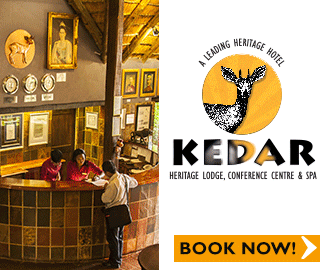
The Zamani Project: Rising From Ruins
BY JO KROMBERG 19TH JAN, 2015 03:04
Miguel de Cervantes Saavedra, the Spanish writer and author of the masterwork 'El quijote', once said: “The phoenix hope, can wing her way through the desert skies, and still defying fortune's spite; revive from ashes and rise.”
In terms of the anthropological context of the area, the data helps us to understand how people who lived hundreds and even thousands of years ago...”
"
He says the project has generally been well received by the countries in which they work. “At first there is some hesitation and suspicion and our motivation is often questioned – local authorities are wondering why we are doing this for free! But once the fieldwork begins, we include local experts and students for on-the-job training and once that happens and we show our results then they generally become very positive. Sometimes we are asked to do further sites.” The Professor says there are serious concerns about potential misuse of the data as well. “We are very careful to make the data available to respected bodies and researchers and scholars only. Unscrupulous tour operators and other opportunistic industries can do a great deal of damage. And we certainly do not want to see our computer models in the form of inappropriate or disrespectful video games. We only trust appropriate government officials, heritage authorities and accredited custodians with the results of our work and we are definitely not in it for commercial gain.” All the work is done pro bono and no one is ever charged a cent for his or her amazing services.
Heinz says it is impossible to say how many sites there are still to be documented in Africa. “There could be hundreds more. In addition to historical and archaeological sites, there are also a wide variety of traditional hut forms in Africa reflecting cultural diversity and different responses to the environment. All these should be recorded before they are replaced with modern dwellings.
How many other institutions around the world are doing similar work and to what extent?
“There are a quite a number yes. But to my knowledge nobody in sub-Saharan Africa spatially documents sites in the same scientific, objective and detailed approach as we are aiming for. There are possibly a couple of laser scans here and there but I am not aware of a similarly complex approach to the holistic documentation of sites in sub-Saharan Africa.”
“In terms of the anthropological context of the area, the data helps us to understand how people who lived hundreds and even thousands of years ago, coped in the environment of the time, how they managed to use materials which were naturally available, sustainable and in tune with the environment and how they were able to construct a life which made living there acceptable. For instance, they used natural material and ingenious designs for cooling purposes, which are more appropriate than our buildings, while causing minimum damage to the environment. In some ways they interacted more sensibly with the environment than us because their more direct dependence on it. We often feel removed from, if not superior to, nature and don’t accept the need to protect it. . African cultures seemed more able to adapt to the environment as, for example reflected in the adobe structures in Mali.”
But the future of this amazing project is bleak.
“At this stage it’s in limbo,” says Heinz. “We are using our last funds to complete three more projects this year. After which the project might have to close down The Zamani team is extremely dedicated and experienced and I consider myself very lucky to work with such a group. We have grown together in the difficult conditions of fieldwork and travelling in remote parts of Africa and developed a very positive team spirit. The thought of the team disintegrating and the project terminating because of a lack of funding is depressing. We are not just a production unit but we are developing methodologies as well and post-grad research is attached to the project. There always have been problems to find funding for research but the recent international economic climate has worsened the problems substantially.”
Working as a geomatician in remote parts of Africa may sound like something from a romance novel but is filled with peril of all kinds. “We do get volunteers to help us but they need to understand that it’s not a picnic out there. They can’t have any illusions of the territory and the often-harsh conditions. It is physically demanding and there are risks like health, safety etc.”
The biggest risk, however, is that these dedicated, deeply committed and passionate scientists may not t be able to continue with their work due to lack of funding. As a continent, we simply cannot afford to lose them. As they say, we are borrowing this land from our children and we owe them a vision of their past.
GPS survey at Petra, Jordan.
GPS survey at Musawwarat Es-Sufra, Sudan.

But sometimes even the Phoenix needs help... Africa is arguably the most misunderstood continent on earth in many senses. It hides secrets, treasures and ancient wisdom in the forms of lost civilizations, architecture, art and cultures. But there is one unit of scientists – very little known and unassuming – that is attempting to uncover and preserve at least a small part of Africa. Under the expert supervision of Professor Heinz Rüther, The Zamani Project was initiated in the Geomatics Division of the University of Cape Town and is currently funded by the Andrew W. Mellon Foundation. The project, founded as "The African Cultural Heritage Sites and Landscapes Project", developed out of years of heritage documentation activities by Prof. Rüther.
“Zamani is the Swahili word for ‘the past’,” he tells me one sunny morning in his modest office at the Engineering Faculty at UCT as I attempt to find out more about the fascinating work they do. I’d never even heard of the term “geomatics” before...
“In layman’s terms, the Zamani Project is a documentation project on African heritage sites which preserves Africa’s history for the future in digital format. The data can be used for conservation, restoration, research and education,” he says. “The documentation comprises of 3D computer models of historical buildings and structures, of Geographic Information Systems, 3D terrain models of surrounding landscapes, panorama photography, videos and other spatial information. It is in the view of modern archaeologists that knowledge of the context of the environment is necessary for the understanding of a site. , A historical site cannot be seen in isolation. We have a geographic information system and a complex database of each site – we also produce sections, elevations and ground plans of the structures. All this is supported by contextual information, which are collected by JStor/Aluka in New York and published in the JStor digital library.”
In other words, the Project attempts to capture the spatial domain of heritage, by accurately recording its physical and architectural nature and dimensions. Sites are seen in the context of their physical environment and landscapes surrounding sites are documented based on satellite and aerial imagery, wherever possible. The documentation project was initiated to increase international awareness of African heritage and provide material for research while, at the same time, creating a permanent metrically accurate record of important sites for restoration and conservation purposes.The project is based on state-of-the art data acquisition and presentation technologies, including laser scanning and close range photogrammetry, which are used to generate Geographic Information Systems, 3D computer models and other spatial data. The work is often complex and difficult in the field. The team has completed documentation work in Ghana, Mali, Kenya, Sudan, Egypt, Cameroon, Mozambique, Ethiopia, Tanzania and South Africa as well as Uganda and Algeria.
So what are the main objectives of the project?
“To provide data for the future, should sites deteriorate or be destroyed ,” says Heinz. “In our efforts to digitally record them we are trying to be holistic. We combine technologies and different ways of conveying information and also our data is used for conservation and restoration, which is an additional objective. At present the data is used for restoration, for instance at Lalibela in Ethiopia by UNESCO and the World Monument Fund and In Songo Mnara in Tanzania by an international team of conservators and archaeologists. The data can also be used for site management, for example at the Wonderwerk Cave in South Africa, the design of a tourist walkway will be based on our data. We also intend to use the data to create replicas (true to scale) of rock art shelters to allow people who cannot physically visit the sites to get an impression in 3D.” It seems the data has endless applications. It can also be used, the Professor tells me, to assist in the control of the effects of natural disasters by providing, for example, information for the design of structures built to protect important archaeological sites from flooding. Rock art is especially exposed to vandalism and, while we cannot protect a site from destruction, our data can help to restore sites. The data can also serve to monitor changes due to erosion, human impact or sea levels rising such as in the case of the fortress on Kilwa Kisiwani in Tanzania which is right on the shore. “In Cameroon there are dry stone strong-holds where the structure of the original building is hard to understand by visual on-site inspection. The researchers working there hope to use our 3D models to restore or reconstruct damaged structures, and determine their original use.” Generally the data can be used to restore some semblance of life as it was before.
So how did his passion for this line of research begin and why Africa?
“It started a long time ago. I was always fascinated with cultures. In high school I had a classic education in Greek and Latin. When I came to Africa I realised that not enough was done about preserving African heritage and culture, albeit for understandable reasons. The sites are difficult to access and there are necessarily other priorities and little money is available to document and protect sites. Many sites are not widely known and only accessible to researchers. I always had a love for Africa and I saw a need and opportunity to do something for sub-Saharan Africa. I must confess that this is not entirely altruistic, I find working in Africa fascinating and challenging and feel greatly privileged being able to work on these sites.” The Andrew W, Mellon Foundation has funded the project for six years and they are now surviving on a shoestring with contributions from a philanthropist and individual minor donations as well as small projects, he says. “We have documented about 40 sites over the last eight e years in 12 countries but there are many more sites to document and we are running out of funding.”














